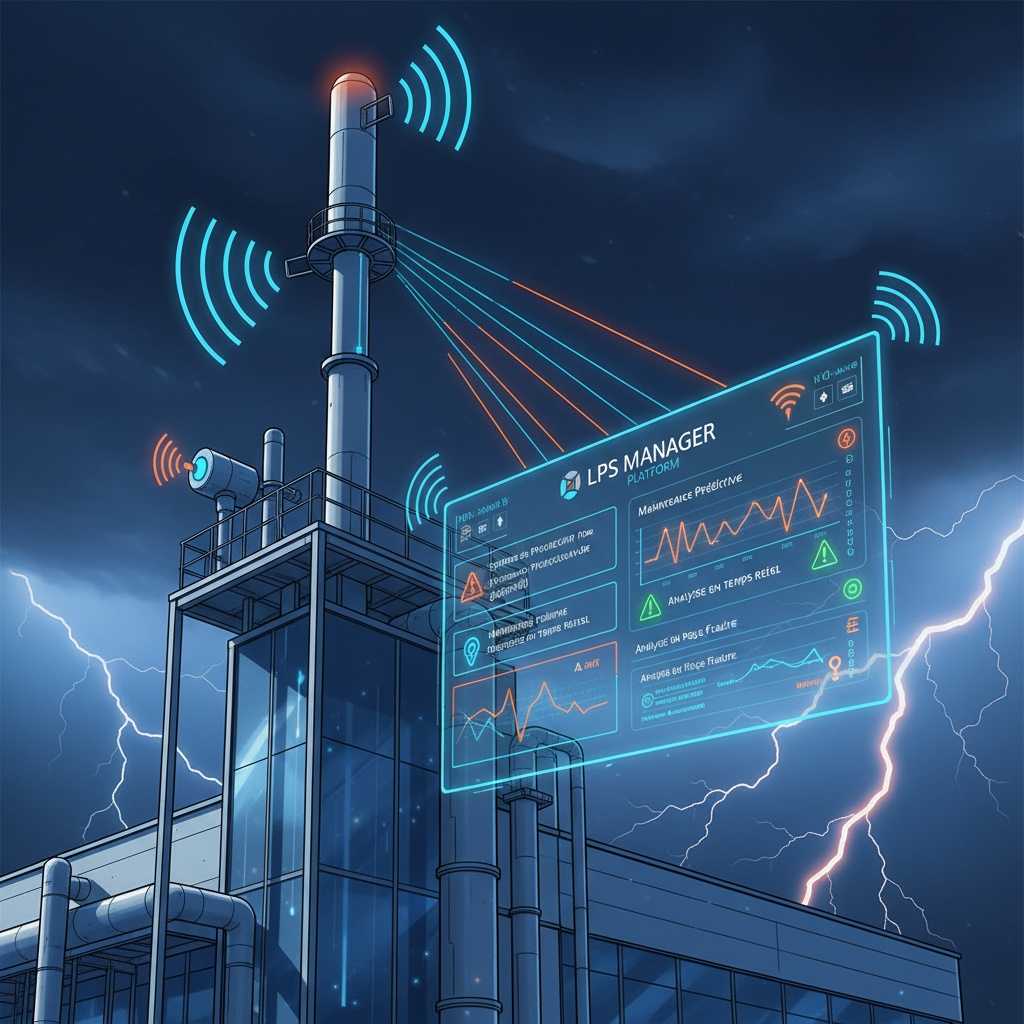Introduction: The Evolution of Lightning Rod Maintenance
Lightning protection is a critical issue for the security of industrial infrastructure, telecommunications, energy facilities, and strategic buildings. Traditionally, maintenance of lightning protection systems (LPS) relied on periodic reactive or preventive inspections, which were often costly, time-consuming, and insufficiently accurate. The advent of the Internet of Things (IoT) and connected monitoring technologies has radically transformed this paradigm, giving rise to predictive maintenance .
This article explores in depth the technical, operational and economic benefits of predictive maintenance applied to lightning protection systems, drawing on technological innovations such as the Contact@ir® LPS Manager platform PARATON@IR connected lightning rods .
1. Understanding Predictive Maintenance in the Context of Lightning Protection
1.1 Definition and Fundamental Principles
Predictive maintenance is an asset management strategy that uses real-time data, IoT sensors, and analytics algorithms to anticipate failures before they occur. Unlike preventive (based on fixed intervals) or corrective (post-failure intervention) maintenance, predictive maintenance optimizes interventions based on the actual condition of the equipment.
For lightning protection systems, this approach involves:
- Continuous monitoring of the integrity of lightning rods (ELLIPS, PARATON@IR)
- Automatic detection of lightning strikes via counters (Compt@ir)
- surge protection devices
- Instant transmission of data to a centralized platform ( LPS Manager )
- Intelligent analysis to identify anomalies and plan interventions
1.2 Normative Framework and Regulatory Requirements
International and French standards impose strict obligations regarding the maintenance of SPFs:
- NF C 17-102:2011 : French standard specific to early streamer emission (ESE) lightning rods, requiring periodic checks of functional integrity. AFNOR reference
- IEC 62305 : Series of international standards covering lightning protection, including risk management and inspections. AFNOR reference
- IEC 50164 : Technical specifications for lightning protection components
Predictive maintenance significantly facilitates regulatory compliance by providing complete traceability and documented evidence of system condition. For early streamer emission lightning rods such as ELLIPS and PARATON@IR, compliance with the NF C 17-102:2011 standard is essential, although some countries do not recognize this standard, which may limit their commercialization in these territories.
2. Technical Advantages of Predictive Maintenance
2.1 Continuous Monitoring and Early Detection of Anomalies
The main technical advantage lies in the ability to continuously monitor the condition of lightning rods without human intervention. Connected systems like PARATON@IR integrate sensors that continuously check:
- Integrity of the initiating device : Detection of mechanical or electrical damage which could compromise the effectiveness of the lightning rod
- Electrical continuity : Permanent verification of the connection with the earthing system, a critical element for the evacuation of lightning currents
- Lightning strikes : Automatic recording via Compt@ir of each event, with precise timestamp and characteristics of the strike
- The status of secondary protections : Real-time monitoring of surge protectors (Alert@ir XT for electrical networks, Alert@ir DC for direct current installations)
This monitoring makes it possible to identify anomalies invisible during traditional visual inspections, such as:
- Micro-cracks in the components of the initiating device
- Progressive oxidation of electrical connections
- Degradation of insulating materials under the effect of UV rays and bad weather
- Weakening of priming capacity following repeated impacts
- Deterioration of earth resistance
- Corrosion of fasteners
ELLIPS lightning rods (non-communicating), maintenance requires physical access and the use of the Test@ir , while PARATON @IR allows continuous remote monitoring, drastically reducing the need for on-site intervention.
2.2 Real-Time Data Transmission via IoT
The IoT architecture of LPS France systems is based on several complementary technologies adapted to different installation contexts:
Contact@ir : Radio transmitter integrated into the lightning rod, transmitting the status data of the initiating device. This system requires a receiver (Dongl@ir or Rout@ir) to route the information to the management platform.
Contact@ir MD : Latest standalone solution (since October 2024), integrating an eSIM card for direct connection to the server via international roaming. This technology works in all conditions and all countries, without dependence on local infrastructure. Battery life is approximately 22 hours (non-lithium batteries, sized according to capacity).
Rout@ir : Long-range receiver (250-300 meters) capable of managing up to 999 devices simultaneously. This system offers:
- Simplified WiFi setup
- Extendable antenna to improve range
- Photovoltaic solar power supply option (75W 12V panels, silicone cable connectors, Spectra solar charger, 12V 18Ah lead crystal battery)
- Remote control of all connected devices
Dongl@ir : Short-range solution for compact installations or small sites, offering a cost-effective alternative for simple configurations.
This technological evolution reflects a constant progression: from the Contact@ir + Dongl@ir system (first generation), to Contact@ir + Rout@ir (improved range and capacity), to the autonomous Contact@ir MD (latest generation), with a new solution expected for December 2025.
These technologies guarantee reliable transmission even in difficult environments: isolated sites, tropical areas with high storm activity, offshore installations, desert regions, high mountain infrastructures. Permanent connectivity is ensured without dependence on local network infrastructure, a decisive advantage for emerging markets in Africa, Southeast Asia and Latin America where LPS France is particularly present.
2.3 Centralization and Analysis of Data: The LPS Manager Platform
LPS Manager is the heart of the predictive maintenance system. This professional cloud platform offers a comprehensive interface for the centralized management of all lightning protection systems:
Unified Dashboard : Real-time visualization of the status of all lightning rods in a site or multi-site portfolio. The interface clearly and intuitively presents the operational status of each device, with immediate visual indicators (green/amber/red) to instantly identify equipment requiring attention.
Complete history : Comprehensive record of all events since commissioning:
- Lightning strikes with date, time and estimated intensity
- Automatically triggered maintenance alerts
- Interventions performed and test results
- Configuration changes
- Correlated weather events
Smart alerts : Automatic multi-channel notification system (email, SMS, push notifications) in the event of an anomaly detected. Alert thresholds can be configured according to the criticality:
- Critical alert: failure detected requiring immediate intervention
- Important alert: progressive deterioration requiring intervention planning
- Information alert: notable event without emergency (lightning strike managed correctly)
Document management : Centralized access to all regulatory and technical documents:
- Certificates of authenticity of equipment
- Legal guarantees and warranty extensions available for Paraton@ir, Ellips, Compt@ir, Alert@ir XT and Alert@ir DC
- Inspection and maintenance reports
- Technical documentation and user manuals
- Integration with contact-platform.com to simplify access to certificates of authenticity and legal guarantees (although the use of this platform is not mandatory to use LPS Manager )
Compliance Reports : Automatic generation of formatted documents for regulatory audits, including:
- Full audit history
- Proof of compliance with standards NF C 17-102:2011 and IEC 62305
- Traceability of interventions
- Lightning strike statistics
- Availability rate of the protection system
Predictive Analytics : Advanced algorithms identify degradation trends and predict future maintenance needs. The system analyzes the evolution patterns of technical parameters to anticipate potential failures several weeks or months in advance.
Lightning event management : Detailed monitoring of each strike with possible correlation to local meteorological data, allowing analysis of protection effectiveness and optimization of future installations.
LPS Manager 's professional interface enables facility managers, design offices, distributors and installers to make informed decisions based on objective data rather than arbitrary estimates or schedules.
3. Operational and Economic Benefits
3.1 Drastic Reduction in Maintenance Costs
Predictive maintenance generates substantial savings on several levels, radically transforming the economics of lightning protection:
Optimized interventions : Elimination of unnecessary routine inspections. Only equipment that truly requires attention is inspected, reducing travel and labor costs by 40 to 60%. For a portfolio of 100 equipped sites, this represents savings of several tens of thousands of euros annually.
Catastrophic Failure Prevention : Early detection prevents complete failures requiring costly emergency replacements. A lightning rod failure can cause considerable collateral damage:
- Structural fire
- Destruction of sensitive electronic equipment
- Production shutdown in industrial facilities
- Data loss in data centers
- Telecommunications service interruption
The cost of this collateral damage far exceeds that of the lightning protection system itself, often by a factor of 100 to 1000. Predictive maintenance therefore constitutes a major economic insurance.
Extended service life : Targeted, timely maintenance preserves component integrity, extending their operational lifespan by 20 to 30%. A properly monitored and maintained lightning rod can operate effectively for 15 to 20 years, compared to 10 to 12 years with traditional maintenance.
Inventory Reduction : Accurate scheduling of service calls allows for just-in-time spare parts management, freeing up tied-up capital. Distributors can optimize their inventory based on actual anticipated needs rather than maintaining large inventories “just in case.”
Human resource optimization : Maintenance teams can focus their skills on value-added interventions rather than routine inspections. A technician can efficiently manage 3 to 4 times more sites with predictive maintenance than with traditional maintenance.
3.2 Improving Availability and Reliability
For critical infrastructure (data centers, oil and petrochemical facilities, telecommunications networks, energy facilities, government and military sites), availability is paramount. Predictive maintenance ensures:
Uptime rate greater than 99.5% : Planned interventions prevent unscheduled downtime. For a data center hosting critical cloud services, every minute of downtime can cost tens of thousands of euros in contractual penalties and reputational damage.
Reduced downtime : Maintenance is coordinated with scheduled intervention windows, minimizing the impact on operations. In continuously operating industrial facilities, this coordination is essential to maintain productivity.
Continuity of protection : No vulnerable period between degradation and detection. The system immediately identifies any anomalies, enabling rapid response before protection is compromised. This continuity is particularly critical in tropical regions where thunderstorm frequency is high.
Operational predictability : Facility managers can confidently plan their budgets and resources, knowing exactly when interventions will be needed. This predictability significantly improves financial and operational management.

